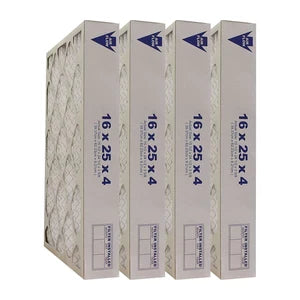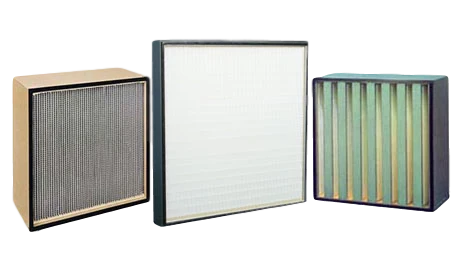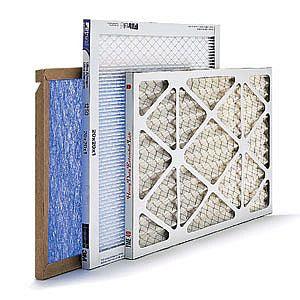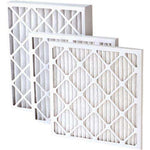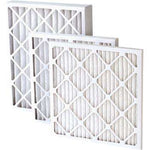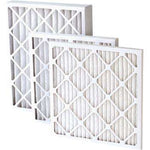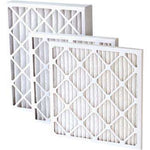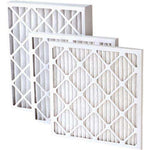You have no items in your shopping cart.

What Size Furnace Filter Do I Need? A Beginner’s Guide To Home Furnace Filter Sizes
The longevity, durability, and functionality of your HVAC system will depend largely on how proactive you are with changing your furnace filters.
But if it’s your first time handling this chore, you may find it a little confusing to buy a replacement filter.
After all, there are so many different types of furnace filters, and they exist in a diverse range of sizes.
How do you know which one works best for your home? And what happens when you install the wrong sized air filter?
Well, in this air filter size guide, we’ll tell you a couple of things you need to know.
We’ll talk about the benefits of changing your air filters regularly, and how to measure the furnace filter dimensions of your HVAC unit.
If you’ve been wondering what the standard furnace filter sizes are, this guide will help you.
Disposable Pleated Filters Are the Most Affordable
Disposable pleated filters are the most cost-effective furnace filters available.
They are constructed from paper and polyester and are generally the least expensive option.
Compared to other filter types, these filters typically last longer and are more effective at trapping large particles.
While fiberglass furnace filters are cheap and easy to install, they don't do much to improve the quality of air you breathe.
They do keep larger particles from entering the system, but they can also increase airflow resistance, making your HVAC system work harder, costing you more money in the long run.
A higher quality furnace filter has a pleated surface that traps a greater variety of particles.
High-efficiency disposable pleated filters, on the other hand, are a more effective option. Compared to fiberglass filters, these filters have a higher MERV rating and can remove minute particles.
Furnace Filter Dimensions
Before you buy a furnace filter, it's helpful to know the dimensions of the one that's currently in your furnace.
Typically, you can find this information on the side of the filter frame.
The dimensions of a furnace filter are in inches and are usually measured in multiples of 1 inch. You can also check the dimensions online.
There are many factors to consider when changing a furnace filter. You can either go with the same model as the one you currently have or try out a new one.
Or, you can choose to go with a different material or get a more advanced air cleaner.
In any case, you must know the dimensions of a furnace filter so that it can fit properly in your furnace.
A filter that’s too small won’t fit snugly in your furnace, allowing unfiltered air to flow around it. This will result in an irritating whistling noise.
A larger filter, on the other hand, will have to be forced into your furnace, which may damage it. Such a filter may also obstruct airflow, causing your HVAC unit to work even harder.
This may not only impact its lifespan but also increase your energy bills.
MERV Rating
The MERV rating of your furnace filter is an important factor to consider when choosing a new filter for your heating system.
Higher ratings are better for improving indoor air quality, while filters with lower ratings can cause your HVAC system to run at less than its maximum capacity.
The MERV rating of a filter is determined by how well it filters particles of different sizes. To calculate MERV ratings, our filters were tested in a laboratory environment.
Particles sized 0.3 to 10 microns were measured.
Then, these particles were grouped into three size ranges.
The first range contains particles that are smaller than a human hair. The second range contains particles between 1.0 and 3.0 um and the third range contains particles that are larger than 10.0 um.
Filters with different MERV ratings can easily trap different sizes of contaminants.
If your system can handle it, we recommend you could look for a MERV rating of at least 13 and preferably higher.
That said, if your filtration needs aren’t too complex, a filter with a MERV 8 rating could work perfectly for your home or office.
Direction of Airflow
One of the most important things to remember when choosing a new furnace filter is the direction of airflow. The direction of airflow will determine which filter you need and which direction to install it in.
You can identify the direction of airflow by looking at an arrow on the filter. It will be pointing toward your furnace from the return duct.
The direction of airflow can also be determined by the orientation of the filter in your furnace. In upflow furnaces, the arrow should point upward, while downflow furnaces should point downward.
Look for a direction arrow printed on the filter frame, as well. If you're unsure, you can also do a string test to confirm the direction of airflow.
Air Filter Size Guide For Beginners
There are so many different home furnace filter sizes. We’d spend the whole day here if we were to describe them all.
That said, the most common filter sizes in the United States and Canada are 16x25x1, 20x25x1, and 16x20x1.
This means the filter is 16 inches wide, 20 inches long, and 1 inch deep/thick. So, if you were wondering how to read furnace filter dimensions, now you know!
Before you buy a new filter, here a few tips to ensure you get the right sized option:
-
Measure the old filter using a ruler or measuring tape. You may find that the actual size is slightly different than the size listed on the frame. Round up your findings.
-
You can measure the dimensions of the air intake to get a more specific size.
-
Consider thicker filters, say 4 to 5 inches, if you’re interested in a snug fit that guarantees higher efficiency protection.
Frequently Asked Questions
Many people all around the country wonder how to measure furnace filter sizes. Today, we’ll answer some of the most common questions about standard furnace filter sizes:
Can I Use a Filter That’s Slightly Different In Size?
No. We don’t recommend using a filter unless it matches the dimensions of your air furnace.
Installing a filter that’s a little too big or a little too small isn’t a good idea. To begin with, it may cause an irritating whistling sound due to air going around the filter.
This unfiltered air will be sucked into your HVAC unit and recirculated around your home.
Is Filter Size the Same Size As the Actual Measurement?
When you buy high-efficiency HVAC filters, you’ll see that they have certain dimensions, eg. 20x25x4, indicated on them. This is the filter’s nominal size.
In reality, however, these allergy-relief air filters have a slightly different actual size.
For instance, a filter whose nominal size is 20x25x1 could have an actual size of 19-15/16 x 24⅞ x 4⅜.
You should always consider the actual size of the filter when buying a replacement, lest you end up choosing one with different dimensions.
What Does MERV Mean In Furnace Filters?
This is the abbreviation for Minimum Energy Reporting Value, a unit of measurement used to calibrate the efficiency of air filters.
The most common furnace filters have a MERV rating ranging from 1 to 16, with the highest figure pointing to super efficient filtration.
Before buying a furnace filter, you should consider your filtration needs. This will give you some insight into the best 16x25x1 furnace filter for your home.
Are 4 Inch Furnace Filters Worth It?
1 inch filters are incredibly common, but many manufacturers are also making an abundance of 4 inch filters.
This size filter is said to help increase the efficiency of filtration, ensuring more air contaminants are trapped.
But if you’ve never tried them before, you’re likely wondering whether they’re worth the hype.
The truth is, these filters can work great for your home, but it’s crucial to check that they’re compatible with your HVAC unit.
This is the best way to make sure they don’t restrict airflow in any way.
How Often Should I Replace My Furnace Filter?
Most filters have their expected lifespan indicated on their packaging or frame. This will tell you how often to change furnace filters in your home.
The duration you wait before changing your filters will also depend on your filtration needs.
For instance, in a home with young kids, pets, or people with sensitive allergies, you may need to swap out that filter every 30-60 days.
Under normal circumstances, however, you can wait at least 45-90 days before changing your filters.
If you keep forgetting to do so, we recommend setting a reminder the day you put a new filter. This way, when the time has passed, you’ll be notified to replace the filters.
We’ve Got the Best 16x25x1 Air Filter For Your Home
Whether you’re the parent of young children or the caregiver to your older parents, we’ve got the best high-efficiency HVAC filters for you.
At United Filters, we understand how important clean, fresh air is to our physical health and emotional wellbeing.
That’s why we’ve gone to such great lengths to manufacture pet-friendly air filters that will give you the protection you need from allergens and other air contaminants.
At United Filters, we’ve got all kinds of filters, from those 1 inch thick to variations that are 4 inches thick.
We can, therefore, manage your filtration needs, regardless of whether you want to install them in your home, office, or business building.
What are you waiting for? Take advantage of our bulk prices and order a pack of our furnace filters today!

What Size Furnace Filter Do I Need? A Beginner’s Guide To Home Furnace Filter Sizes
The longevity, durability, and functionality of your HVAC system will depend largely on how proactive you are with changing your furnace filters.
But if it’s your first time handling this chore, you may find it a little confusing to buy a replacement filter.
After all, there are so many different types of furnace filters, and they exist in a diverse range of sizes.
How do you know which one works best for your home? And what happens when you install the wrong sized air filter?
Well, in this air filter size guide, we’ll tell you a couple of things you need to know.
We’ll talk about the benefits of changing your air filters regularly, and how to measure the furnace filter dimensions of your HVAC unit.
If you’ve been wondering what the standard furnace filter sizes are, this guide will help you.
Disposable Pleated Filters Are the Most Affordable
Disposable pleated filters are the most cost-effective furnace filters available.
They are constructed from paper and polyester and are generally the least expensive option.
Compared to other filter types, these filters typically last longer and are more effective at trapping large particles.
While fiberglass furnace filters are cheap and easy to install, they don't do much to improve the quality of air you breathe.
They do keep larger particles from entering the system, but they can also increase airflow resistance, making your HVAC system work harder, costing you more money in the long run.
A higher quality furnace filter has a pleated surface that traps a greater variety of particles.
High-efficiency disposable pleated filters, on the other hand, are a more effective option. Compared to fiberglass filters, these filters have a higher MERV rating and can remove minute particles.
Furnace Filter Dimensions
Before you buy a furnace filter, it's helpful to know the dimensions of the one that's currently in your furnace.
Typically, you can find this information on the side of the filter frame.
The dimensions of a furnace filter are in inches and are usually measured in multiples of 1 inch. You can also check the dimensions online.
There are many factors to consider when changing a furnace filter. You can either go with the same model as the one you currently have or try out a new one.
Or, you can choose to go with a different material or get a more advanced air cleaner.
In any case, you must know the dimensions of a furnace filter so that it can fit properly in your furnace.
A filter that’s too small won’t fit snugly in your furnace, allowing unfiltered air to flow around it. This will result in an irritating whistling noise.
A larger filter, on the other hand, will have to be forced into your furnace, which may damage it. Such a filter may also obstruct airflow, causing your HVAC unit to work even harder.
This may not only impact its lifespan but also increase your energy bills.
MERV Rating
The MERV rating of your furnace filter is an important factor to consider when choosing a new filter for your heating system.
Higher ratings are better for improving indoor air quality, while filters with lower ratings can cause your HVAC system to run at less than its maximum capacity.
The MERV rating of a filter is determined by how well it filters particles of different sizes. To calculate MERV ratings, our filters were tested in a laboratory environment.
Particles sized 0.3 to 10 microns were measured.
Then, these particles were grouped into three size ranges.
The first range contains particles that are smaller than a human hair. The second range contains particles between 1.0 and 3.0 um and the third range contains particles that are larger than 10.0 um.
Filters with different MERV ratings can easily trap different sizes of contaminants.
If your system can handle it, we recommend you could look for a MERV rating of at least 13 and preferably higher.
That said, if your filtration needs aren’t too complex, a filter with a MERV 8 rating could work perfectly for your home or office.
Direction of Airflow
One of the most important things to remember when choosing a new furnace filter is the direction of airflow. The direction of airflow will determine which filter you need and which direction to install it in.
You can identify the direction of airflow by looking at an arrow on the filter. It will be pointing toward your furnace from the return duct.
The direction of airflow can also be determined by the orientation of the filter in your furnace. In upflow furnaces, the arrow should point upward, while downflow furnaces should point downward.
Look for a direction arrow printed on the filter frame, as well. If you're unsure, you can also do a string test to confirm the direction of airflow.
Air Filter Size Guide For Beginners
There are so many different home furnace filter sizes. We’d spend the whole day here if we were to describe them all.
That said, the most common filter sizes in the United States and Canada are 16x25x1, 20x25x1, and 16x20x1.
This means the filter is 16 inches wide, 20 inches long, and 1 inch deep/thick. So, if you were wondering how to read furnace filter dimensions, now you know!
Before you buy a new filter, here a few tips to ensure you get the right sized option:
-
Measure the old filter using a ruler or measuring tape. You may find that the actual size is slightly different than the size listed on the frame. Round up your findings.
-
You can measure the dimensions of the air intake to get a more specific size.
-
Consider thicker filters, say 4 to 5 inches, if you’re interested in a snug fit that guarantees higher efficiency protection.
Frequently Asked Questions
Many people all around the country wonder how to measure furnace filter sizes. Today, we’ll answer some of the most common questions about standard furnace filter sizes:
Can I Use a Filter That’s Slightly Different In Size?
No. We don’t recommend using a filter unless it matches the dimensions of your air furnace.
Installing a filter that’s a little too big or a little too small isn’t a good idea. To begin with, it may cause an irritating whistling sound due to air going around the filter.
This unfiltered air will be sucked into your HVAC unit and recirculated around your home.
Is Filter Size the Same Size As the Actual Measurement?
When you buy high-efficiency HVAC filters, you’ll see that they have certain dimensions, eg. 20x25x4, indicated on them. This is the filter’s nominal size.
In reality, however, these allergy-relief air filters have a slightly different actual size.
For instance, a filter whose nominal size is 20x25x1 could have an actual size of 19-15/16 x 24⅞ x 4⅜.
You should always consider the actual size of the filter when buying a replacement, lest you end up choosing one with different dimensions.
What Does MERV Mean In Furnace Filters?
This is the abbreviation for Minimum Energy Reporting Value, a unit of measurement used to calibrate the efficiency of air filters.
The most common furnace filters have a MERV rating ranging from 1 to 16, with the highest figure pointing to super efficient filtration.
Before buying a furnace filter, you should consider your filtration needs. This will give you some insight into the best 16x25x1 furnace filter for your home.
Are 4 Inch Furnace Filters Worth It?
1 inch filters are incredibly common, but many manufacturers are also making an abundance of 4 inch filters.
This size filter is said to help increase the efficiency of filtration, ensuring more air contaminants are trapped.
But if you’ve never tried them before, you’re likely wondering whether they’re worth the hype.
The truth is, these filters can work great for your home, but it’s crucial to check that they’re compatible with your HVAC unit.
This is the best way to make sure they don’t restrict airflow in any way.
How Often Should I Replace My Furnace Filter?
Most filters have their expected lifespan indicated on their packaging or frame. This will tell you how often to change furnace filters in your home.
The duration you wait before changing your filters will also depend on your filtration needs.
For instance, in a home with young kids, pets, or people with sensitive allergies, you may need to swap out that filter every 30-60 days.
Under normal circumstances, however, you can wait at least 45-90 days before changing your filters.
If you keep forgetting to do so, we recommend setting a reminder the day you put a new filter. This way, when the time has passed, you’ll be notified to replace the filters.
We’ve Got the Best 16x25x1 Air Filter For Your Home
Whether you’re the parent of young children or the caregiver to your older parents, we’ve got the best high-efficiency HVAC filters for you.
At United Filters, we understand how important clean, fresh air is to our physical health and emotional wellbeing.
That’s why we’ve gone to such great lengths to manufacture pet-friendly air filters that will give you the protection you need from allergens and other air contaminants.
At United Filters, we’ve got all kinds of filters, from those 1 inch thick to variations that are 4 inches thick.
We can, therefore, manage your filtration needs, regardless of whether you want to install them in your home, office, or business building.
What are you waiting for? Take advantage of our bulk prices and order a pack of our furnace filters today!
